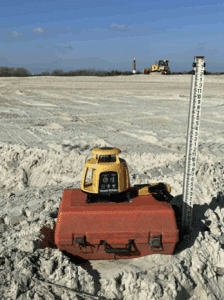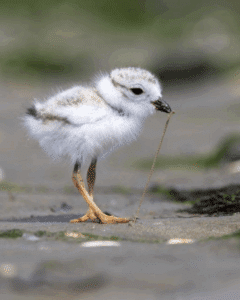Barnegat Light Habitat Restoration Breeding Update
The Barnegat Light habitat restoration site has wrapped up its best breeding season for beach nesting birds since the start of the restoration project in 2019. This is exciting news given it was a challenging year at many other breeding sites along the New Jersey coast this year.

Piping plovers, the prime focus of the restoration, had an especially good season. Seventeen (17) fledglings were produced from six pairs for a fledge rate of 2.83 per pair, well above the federal recovery goal of 1.50 fledglings per pair and even more above the anticipated statewide rate for 2025. The six pairs represent the high number for the restoration site, up from one breeding pair remaining at the inlet just before the project began.

American oystercatchers also saw an uptick of breeding pairs this year, up to four pairs from a previous high of two. Although they were not as productive as plovers this season, only two chicks fledged overall, they still meet the long-term, range wide goal for the species of 0.50 fledglings per pair at the site. As a longer-lived species, oystercatchers do not need to produce as many fledglings per year to maintain or grow their population.
The biggest surprise of the season might have been the least tern colony at the site, by far the largest and most productive one since the restoration began. A total 70 breeding pairs fledged nearly 60 chicks, making it one of the top least tern colonies in the state. Colonial nesters have had a tough time at the site due to predator pressures, but New Jersey Fish and Wildlife (NJFW), who manage and monitor nesting at the site, deployed a novel technique called “fladry” this year. The colony was surrounded with the fladry, which is basically string with long streamers attached to it, this method has shown promise as a way to deter predators, such as red fox and coyotes, from the nesting area.
Of note, nearly the entire least tern colony occupied the newest section of the restoration area. In the winter of 2025, under the direction of Conserve Wildlife Foundation of New Jersey (CWF), an additional 3-4 acres of the site, the last remaining unrestored portion, were cleared and prepared for nesting. In addition to the tern colony, one each of the pairs of plovers and oystercatchers also nested in this new area. The principal goal of restoring the new area was to allow for additional pairs to nest at the site. Mission accomplished!
The Barnegat Light habitat restoration project is a collaborative effort between CWF, NJFW, U.S. Fish and Wildlife Service, U.S. Army Corps of Engineers, and Rutgers, the State University of New Jersey. Nesting results from this
report are preliminary and were provided by NJFW.
Discover more from Conserve Wildlife Foundation of NJ
Subscribe to get the latest posts sent to your email.
Leave a Comment
Awesome news and great support for our shore birds. Thank you all for this work and report!!!!
Great job. Setting the bar high for every other site.
Good news!
Comments are closed.